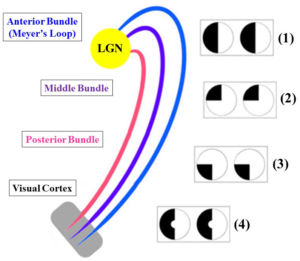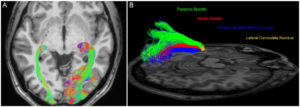1. Párraga RG, Ribas GC, Welling LC, et al. Microsurgical anatomyof the optic radiation and related fibers in 3-dimensional images. Neurosurgery. 2012; 71(Suppl 1): 160-171. doi: 10.1227/NEU.0b013e3182556fde
2. Pujari VB, Jimbo H, Dange N, et al. Fiber dissection of the visualpathways: analysis of the relationship of optic radiations to lateral ventricle: a cadaveric study. Neurol India. 2008; 56(2): 133-137. doi: 10.4103/0028-3886.41989
3. Nilsson D, Starck G, Ljungberg M, et al. Intersubjectvariability in the anterior extent of the optic radiation assessed by tractography. Epilepsy Res. 2007; 77(1): 11-16. doi: 10.1016/j.eplepsyres.2007.07.012
4. Longo D, Fauci A, Kasper D, et al. Harrison’s Principles of Internal Medicine. 18th ed. McGraw-Hill Professional, 2011: 1 and 2.
5. Greenberg D, Aminoff M, Simon R. Clinical Neurology 8/E. McGraw-Hill Professional, 2012.
6. Baldwin MK, Kaskan PM, Zhang B, et al. Cortical and subcortical connections of V1 and V2 in early postnatal macaque monkeys. J Comp Neurol. 2012; 520(3): 544-569. doi: 10.1002/cne.22732
7. Alvarez I, Schwarzkopf DS, Clark CA. Extrastriate projections in human opticradiation revealed by fMRI-informed tractography. Brain Struct Funct. 2015; 220(5): 2519-2532. doi: 10.1007/s00429-014-0799-4
8. Arrigo A, Calamuneri A, Mormina EM, et al. New Insights in the optic radiations connectivity in the human brain. Invest Ophthalmol Vis Sci. 2016; 57(1): 1-5. doi: 10.1167/iovs.15-18082
9. Bridge H, Thomas O, Jbabdi S, Cowey A. Changes inconnectivity after visual cortical brain damage underlie alteredvisual function. Brain. 2008; 131: 1433-1444. doi: 10.1093/brain/awn063
10. Schmid MC, Mrowka SW, Turchi J, et al. Blindsight depends on the lateral geniculate nucleus. Nature. 2010; 466(7304): 373- 377. doi: 10.1038/nature09179
11. Bridge H, Hicks SL, Xie J, et al. Visual activation of extra-striatecortex in the absence of V1 activation. Neuropsychologia. 2010; 48: 4148-4154. doi: 10.1016/j.neuropsychologia.2010.10.022
12. Jones DK, Cercignani M. Twenty-five pitfalls in the analysis ofdiffusion MRI data. NMR Biomed. 2010; 23(7): 803-820. doi: 10.1002/nbm.1543
13. Farquharson S, Tournier JD, Calamante F, Fabinyi G, et al. White matter fiber tractography: whywe need to move beyond DTI. J Neurosurg. 2013; 118(6): 1367-1377. doi: 10.3171/2013.2.JNS121294
14. Kier EL, Staib LH, Davis LM, Bronen RA. MR imaging of thetemporal stem: anatomic dissection tractography of the uncinatefasciculus, inferior occipitofrontal fasciculus, and Meyer’s loop of theoptic radiation. AJNR Am J Neuroradiol. 2004; 25(5): 677-691.
15. Peltier J, Verclytte S, Delmaire C, et al. Microsurgical anatomy of the temporal stem: clinical relevance and correlations with diffusion tensor imaging fiber tracking. J Neurosurg. 2010; 112(5): 1033-1038. doi: 10.3171/2009.6.JNS08132
16. Rabbo AF, Koch G, Lefevre C, Seizeur R. Direct geniculo-extrastriate pathways: a review of the literature. Surg Radiol Anat. 2015; 37: 891-899. doi: 10.1007/s00276-015-1450-7
17. Tournier JD, Calamante F, Connelly A. Robust determination of the fibre orientation distribution in diffusion MRI: nonnegativity constrained super-resolved spherical deconvolution. Neuroimage. 2007; 35: 1459-1472. doi: 10.1016/j.neuroimage.2007.02.016
18. Tournier JD, Yeh CH, Calamante F, et al. Resolving crossing fibres using constrained spherical deconvolution: validation using diffusion weighted imaging phantom data. Neuroimage. 2008; 42: 617-625. doi: 10.1016/j.neuroimage.2008.05.002
19. Jeurissen B, Leemans A, Tournier JD, et al. Investigating the prevalence of complex fiber configurationsin white matter tissue with diffusion magnetic resonance imaging. Hum Brain Mapp. 2013; 34: 2747-2766. doi: 10.1002/hbm.22099
20. Lim JC, Phal PM, Desmond PM, et al. Probabilistic MRI tractography of the optic radiation using constrained spherical deconvolution: a feasibility study. PLoS One. 2015; 10(3): e0118948. doi: 10.1371/journal.pone.0118948
21. Martínez-Heras E, Varriano F, Prčkovska V, et al. Improved framework for tractography reconstruction of the optic radiation. PLoS One. 2015; 10(9): e0137064. doi: 10.1371/journal.pone.0137064
22. Ferrera VP, Nealey TA, Maunsell JH. Responses in macaquevisual area V4 following inactivation of the parvocellular and magnocellular LGN pathways. J Neurosci. 1994; 14(4): 2080-2088.
23. Ungerleider LG, Galkin TW, Desimone R, Gattass R. Cortical connections of area V4 in the macaque. Cereb Cortex. 2008; 18: 477-499. doi: 10.1093/cercor/bhm061
24. Duncan JS. Imaging in the surgical treatment of epilepsy. Nat Rev Neurol. 2010; 6: 537-550. doi: 10.1038/nrneurol.2010.131
25. Winston GP, Daga P, Stretton J, et al. Optic radiation tractography and vision inanterior temporal lobe resection. Ann Neurol. 2012; 71(3): 334-341. doi: 10.1002/ana.22619
26. Piper RJ, Yoong MM, Kandasamy J, Chin RF. Application of diffusion tensor imaging and tractography of the optic radiation inanterior temporal lobe resection for epilepsy: a systematic review. Clin Neurol Neurosurg. 2014; 124C: 59-65. doi: 10.1016/j.clineuro.2014.06.013
27. Cho JM, Kim EH, Kim J, et al. Clinical use of diffusion tensor image-merged functional neuronavigationfor brain tumor surgeries: review of preoperative, intraoperative, andpostoperative data for 123 cases. Yonsei Med J. 2014; 55(5): 1303-1309. doi: 10.3349/ymj.2014.55.5.1303
28. Mormina E, Longo M, Arrigo A, et al. MRI tractography of corticospinal tract and arcuate fasciculus in high-grade gliomas performed by constrained spherical deconvolution: qualitative and quantitative analysis. AJNR Am J Neuroradiol. 2015; 36(10): 1853-1858. doi: 10.3174/ajnr.A4368
29. Arrigo A, Mormina E, Calamuneri A. The pre-surgical planning of brainneoplasms: from diffusion tensor imaging to more advanced approaches. Radiol Open Journal. 2015; 1(1): e1-e5.
30. Jellison BJ, Field AS, Medow J, et al. Diffusion tensor imaging of cerebral white matter: a pictorialreview of physics, fiber tract anatomy, and tumor imaging patterns. AJNR Am J Neuroradiol. 2004; 25(3): 356-369.
31. Dai H, Mu KT, Qi JP, et al. Assessment of lateral geniculate nucleus atrophywith 3T MR imaging and correlation with clinical stage of glaucoma. AJNR Am J Neuroradiol. 2011; 32(7): 1347-1353. doi: 10.3174/ajnr.A2486
32. El-Rafei A, Engelhorn T, Wärntges S, et al. Glaucoma classification based on histogram analysis of diffusion tensor imaging measures in the optic radiation. ComputerAnalysis of Images and Patterns Lecture Notes in Computer Science. 2011; 6854: 529-536.doi:10.1007/978-3-642-23672-3_64
33. Liu Y, Duan Y, He Y, et al. A tract-based diffusion study of cerebral white matter inneuromyelitis optica reveals widespread pathological alterations. Mult Scler. 2012; 18(7): 1013-1021. doi: 10.1177/1352458511431731








